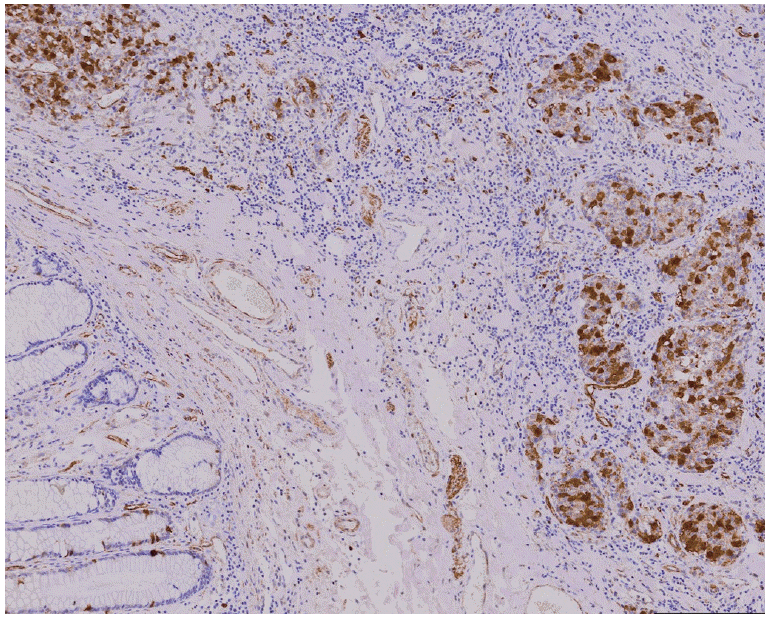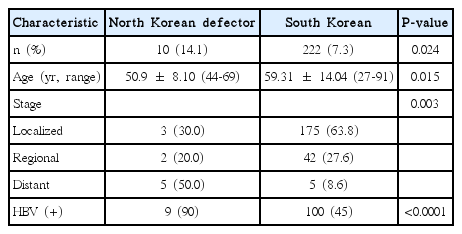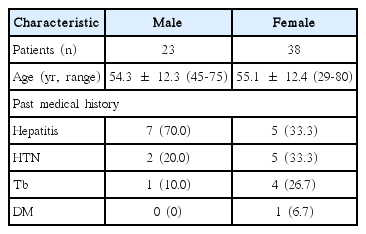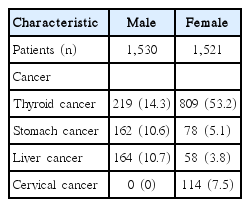북한 이탈 주민에서 발생한 암의 임상병리적 특징
Clinicopathologic characteristics of cancer of North Korean defectors
Article information
Trans Abstract
Purpose:
In this study, we compared characteristics of cancer of North Korean defectors to South Korean. In order to clarify the clinicopathologic characteristics of cancer in North Korean defectors.
Methods:
This study is a retrospective study through chart review of patients diagnosed as cancer at National Medical Center from 2008 to 2013. Control group included South Korean cancer patients who were diagnosed as cervical cancer, thyroid cancer, liver cancer, stomach cancer at same hospital during same period. Two groups were analyzed and compared by sex, age, past medical history, cancer origin, cancer stage, and treatment.
Results:
Among 1,760 North Korean defector patient registered in National Medical Center, 61 patients were diagnosed as cancer, which was 3.5%. Cervical cancer (19.7%), thyroid cancer (19.7%), liver cancer (14.1%) and stomach cancer (10.3%) were 4 most frequent cancer. In South Korean cancer patient, percentage was as follows: thyroid cancer (33.7%), stomach cancer (7.8%), liver cancer (7.3%), cervical cancer (3.7%).
Conclusion:
Cancers closely related to socio-economic status, such as cervical cancer and hepatitis-B related liver cancer, were relatively more frequent in North Korean defectors than South Koreans. As for cancers in which early diagnosis is important such as thyroid cancer and stomach cancer, there were no significant differences in age-prevalence, disease course and treatment.
서 론
1970년대 초반 이후 북한의 보건의료시스템은 점차 쇠퇴해갔다. 북한은 구 소련과 동구권의 잇단 붕괴와 김일상 사망 후 2대 세습체제 유지 및 국내외 정치적 환경변화, 수 차례 지속된 자연재해, 안보 문제 등이 원인이 되어 극심한 경제난에 시달리게 되었다[1]. 이렇게 보건 의료의 하부시스템이 악화되자, 1980년대까지 이룩했던 보건 의료시스템 및 기대여명 연장 등의 보건의료 성과들도 무너졌다. 이에 따라 북한주민들의 건강상태는 전반적으로 열악해졌다[1,2]. 식량 안보뿐만이 아니라, 높은 영아사망률과 모성사망률, 낮은 기대여명, 영양실조 및 감염 병의 빈발 등 국제보고서의 수치가 이를 반증한다[2].
북한이탈주민의 국내입국 규모는 1998년 이후 매년 꾸준히 증가하고 있다. 2007년 2월 북한이탈주민 총 입국자수가 1만명을 넘어섰고, 2010년 12월말까지 총 20,399명의 북한이탈주민이 국내에 입국하였다[3]. 성별 입국비율을 살펴보면 여성의 입국비율은 2002년을 기점으로 남성을 추월하여 2009년도에는 약 77%를 차지하고 있다[3]. 2006년 질병관리본부에서 시행한 북한이탈주민을 대상으로 한 건강검진상 면역도, 감염률, 미 충족 의료 수요율(medical unmetneeds)에서 남북 간에 큰 차이를 보이는 것으로 나타났으며 이는 통일 후 발생할 의료수요에 대한 예측이 필요함을 의미한다[4].
남한과 북한은 같은 민족으로 같은 유전자를 공유하지만 환경의 영향에 따른 암 발병을 무시할 수는 없다[5]. 다른 환경에서 거주하며 같은 유전자를 공유하는 한 민족의 암 발생을 조사함에 있어 북한이탈주민에 대한 연구는 기본적인 예측 자료로 활용할 수 있음이 예상된다. 일례로 미국 등 선진국의 경우 난민에 대한 질병감시체계가 이루어져있어 발생 가능한 질환에 대처하기 위한 자료로 사용하고 있다[6]. 둘째로 남북한 사회와 의료를 비교 연구하는 데 있어 암 발병 현황 자료의 가치 또한 의료 복지지표로서 기능 할 수 있다[7].통계치 산출방식의 차이와 자료의 신뢰성에 대한 의문 때문에 북한에서 발표된 의료 지표의 통계치 만으로 북한 사회상과 의료의 질에 있어서의 변화를 이해하는 것은 극도로 어렵다. 물론 북한 인구 전체를 모집단으로 한 암 발병 자료도 현재로서는 확보할 수 없는 상태이다. 단지 남한으로 입국하는 북한이탈주민은 70대부터 어린이에 이르기까지 모든 연령대와 성별을 망라하고 있어서 이들의 암 유병 현황을 조사하여 이를 이들의 사회경제적 배경정보와 함께 해석하면 1930년대 이후에 출생한 북한 인구집단의 암환자의 특성을 유추할 수 있을 것으로 기대된다[8,9].
본 연구에서는 북한이탈주민과 남한의 암 환자들의 암 특성을 비교하여 북한이탈주민에서 발생하는 암의 임상병리학적 특성을 밝히고자 하였다[10].
방 법
국립중앙의료원은 북한이탈주민에 대한 진료비 지원을 하고 있어 서울, 경기 지역의 북한이탈주민이 가장 많이 등록되어 있다. 2008년 1월부터 2013년 12월까지 국립중앙의료원에 등록된 1,760명의 북한이탈주민 중에 암 진단을 받은 61명의 환자들을 연구군으로 선정하여 그들의 성별, 나이, 과거력과 암의 발병부위와 병기를 조사했다(Figs. 1, 2). 같은 기간에 국립중앙의료원에서 환자들 중 외국인 및 북한이탈주민을 제외한 대한민국국적의 암환자를 대상으로 성별, 나이, 과거력과 암의 발병부위와 병기를 조사하였다. 이 중 북한이탈주민에서 가장 흔한 암종 4개에 해당하는 갑상선암, 자궁경부암, 위암, 간암 환자를 대조군으로 선정하였다.

Cancer distribution of North Korean defectors patients registered at National Medical Center. (A) Male. (B) Female.
과거력은 고혈압, 당뇨, 간염, 결핵의 병력에 대해서 조사하였다. 고혈압과 당뇨의 경우 진단 후 약물 복용력이 있는 환자들을 포함하였고, 간염의 경우 혈액검사상 보균자 또는 급. 만성 간염이 확진 된 환자들을 포함시켰다. 결핵의 경우 과거력상 결핵 진단 후 약물 복용한 과거력이 있는 환자 및 현재 치료중인 환자들을 포함하였다. 병기는 미국의 국가 암 연구센터에서 개발한 Surveillance, Epidemiology, and End Results 프로그램에서 사용중인 국한/국소진행/원격전이 요약병기를 사용하였다[11[. 치료에 있어서는 수술, 항암치료, 방사선치료, 보존적 치료의 4그룹으로 나누어졌다. 수술은 원발 부위 혹은 전이 병소에 대한 고식적 수술 및 근치적 수술을 모두 포함하였다. 항암치료의 경우 정맥 내 주사, 경구 항암제 등 전통적 항암요법과 항암제를 이용한 화학 색전술을 포함하였다. 방사선 치료의 경우 외부방사선치료 및 근접치료를 모두 포함하였다. 두 그룹 간에 환자수의 규모가 차이가 심하여 발생분율을 계산하여 두 그룹 간의 암 발생 분포를 비교하고자 하였다. 통계분석은 IBM SPSS ver. 20(IBM Co., Armonk, NY, USA)을 사용하여 이루어졌다. 단일인자분석에 있어서, 범주형 자료는 카이 제곱과 피셔 테스트로, 연속형 자료는 t-test로 검정하였다. 0.05 이하의 P값은 통계적으로 유의한 것으로 판단하였다.
결 과
북한이탈주민 환자 1,760명 중 해당기간에 암으로 진단된 환자수는 모두 61명으로 전체 환자 중 3.5%가 암환자였다. 남자가 23명, 여자가 38명으로 성비는 1:1.65였다. 평균 나이는 남성이 54.3± 12.3세, 여성이 55.1± 12.4세로 나타났다(Table 1). 대조군은 전체 암 환자수가 3,051명이었고 남자 환자가 1,530명 여자 환자가 1,531명으로 성비는 1:1이었다(Table 2).
장기별 암 발생분율을 대조군과 비교해본 결과 연구군에서는 자궁 경부암이 19.7%로 가장 많았다. 여성으로 한정하였을 때 연구군의 경우에 자궁경부암 환자가 31.6%로 나타났으며, 대조군에서는 7.5%로 나타나 연구군의 경우에 높게 나타났다. 연령의 경우에 연구군이 51.6세, 대조군의 경우는 44.8세로 나타났다. 병기의 경우에는 연구군에서 국소전이, 원격전이가 대조군보다 높게 나타났으나 유의한 차이를 보이지는 않았다(Table 3).

Characteristics of cervical cancer patients registered at National Medical Center (foreigners excluded)
갑상선암은 연구군의 19.7%에서 발생하여 자궁 경부암과 함께 가장 많이 발생한 암이었다. 두 군 간에 진단 당시의 평균연령, 종양크기 및 병기의 유의한 차이는 없었다(Table 4).

Characteristics of thyroid cancer patients registered at National Medical Center (foreigners excluded)
연구군의 간암 발생분율이 16.3%를 차지하고 있었다. 남녀 비율은 4:1로 남자 환자가 많았다. 대조군에서는 7.5%의 발병분율을 보여 연구군에서 보다 높은 발병분율을 보였다. 발병 연령의 경우에 연구군에서 낮게 나타났으며 원격전이가 유의하게 높은 것으로 나타났다. 연구군에서 B형간염 환자 및 보균자의 빈도가 대조군에 비해 유의하게 높은 양상을 보였다(Table 5).

Characteristics of liver cancer patients registered at National Medical Center (foreigners excluded)
위암이 11.5%로 4위를 차지하고 있었다. 남녀 비율은 5:2로 남자 환자가 많았다. 연구군의 남녀 비를 고려할 때 남자들에서 비교적 많이 발생하는 것으로 나타났다. 대조군에서는 7.8%의 발병분율을 보였고 두 그룹 간에 발생빈도, 발생연령에서 유의미한 차이를 보이지 않았다. 병기에서는 연구군이 대조군에 비해 조기 위암이 많은 것으로 나타났다(Table 6).
고 찰
연구군에서는 자궁경부암이 19.7%로 가장 많았다. 여성으로 한정하여 보면 전체 여성 암환자의 31.5%가 자궁경부암 환자였다. 이는 대조군의 여성 암환자 중 자궁경부암이 차지하는 비율이 7.5%임을 감안할 때 상대적으로 높은 비율이었다. 연구군의 연령이 대조군에 비해 고령인 경향을 보였다. 자궁경부암은 해당지역의 사회경제적 수준과 밀접한 연관이 있는 질환이다. 자궁경부암의 선별검사가 이루어지기 위해서는 의료접근성, 경제수준, 인구구성 및 교육수준을 포함한 사회경제적 수준이 중요한 요인이 되기 때문이다[12,13]. 그렇기 때문에 북한에서 새로이 유입되는 북한이탈주민의 입국 시 자궁경부암에 대한 선별검사가 철저히 이루어져야 하며 향후 20–30대의 젊은 세대의 북한이탈주민에서의 자궁경부암의 발병추이를 관찰하여 비교하는 것이 필요할 것으로 보인다.
갑상선암이 19.7%로 공동으로 가장 많았다. 대조군의 암환자 중 갑상선암이 차지하는 비율은 33.7%이지만 본 기관에서 갑상선외과 진료가 시작된 2012년 1월부터 2013년 12월에 진단된 환자가 940명으로 전체 대조군의 91.4%를 차지하여, 타 병원에서 갑상선암 진단 후 수술을 위해 본원을 방문하는 환자 수의 급증이 선택성 편향으로 작용하였다. 반면에 연구군은 2008년부터 2011년까지 진단된 환자가 5명(41.7%), 2012년부터 2013년까지 진단된 환자가 7명(58.3%)로 진료시기에 따른 편향은 없었다. 두 군 간의 갑상선 암의 진단 시 평균 나이, 평균 종양 크기, 병리, 병기의 차이는 없었다. 또한 전체 갑상선유두암 환자 중 갑상선 미세유두암(size≤1 cm) 비율은 연구군이 58.3%, 대조군에서 52%로 유의한 차이를 보이지 않았다(P=0.524). 하지만, 북한이탈주민의 진단 전 남한 내 거주 기간과 북한 이탈 시기, 이탈 후 경로 등의 조사가 불가능하여 노출된 환경인자의 영향 등을 고려하지 못하였기 때문에, 연구군과 대조군에서 발병한 갑상선암의 임상병리적 특징과 갑상선 미세유두암 비율의 유사성을 북한이탈주민이 국내에서 받은 갑상선암 검진의 효과라고 단정할 수 없다[14-16].
간암의 경우 90%의 연구군 환자가 B형간염환자 또는 보균자였다. C형간염 환자 및 보균자는 없었고 1명의 환자만이 B형과 D형간염의 동시감염자였다. 그 외 알코올성 간경화 등 다른 원인에 의한 간암발병 환자는 1명이었다. 대조군에서 B형간염 보균자 및 환자가 45%, C형간염 환자 및 보균자가 5%, 동시감염자가 1%, 3%에서 알코올성 간 경화 등 다른 원인에 의한 간경화를 보인 것과 다른 결과를 보였다. C형간염(보균자포함), 알코올성 간경화의 경우에는 유의한 차이를 보이지 않았으나 B형간염(보균자포함)의 경우에는 북한이 상대적으로 남한보다 높은 비율을 보임이 유의하게 나타났다. 결론적으로 연구군의 환자들이 B형간염에 대한 예방, 진단 및 치료를 대조군에 비해 잘 받지 못한 것 때문으로 생각된다. B형간염 자체가 사회경제적 수준과 밀접한 연관이 있는 질환으로 인구밀도가 높고 위생이 잘 이루어지지 않은 환경에서 잘 발병하며 사회경제적 수준이 낮은 지역에서는 예방접종 등이 잘 이루어지지 않아 B형간염의 유병률이 높고 치료 또한 잘 이루어지지 않기 때문에 간암으로 발전하는 빈도가 높다[17]. 실제로 북한의 B형 간염 유병률은 1%–10% 정도로 매우 높은 편이다[18]. 따라서 북한이탈주민의 입국 시 B형간염에 대한 선별검사 및 치료가 필요하다. 또한 향후 통일이 될 경우 B형간염 백신 등 기본 예방접종에 대한 대책을 염두에 두어야 할 것이다.
이 연구의 제한점은 연구군에 해당되는 환자의 수가 많지 않아 통계분석이 큰 의미를 주지 못했으며 환자의 예후에 대한 비교는 이루어지지 않았다. 단일기관연구이기 때문에 선택성 편향이 발생한 것을 간과할 수 없다. 또한 갑상선암은 북한이탈주민의 이탈 후 국내유입까지의 기간 및 경로와 국내 거주 기간을 조사할 수 없어 암 생물학적 차이, 환경적 요인의 차이, 조기 암 검진의 효과에 대한 판단은 할 수 없었다. 따라서 본 연구를 바탕으로 다수의 의료기관이 참가하는 장기적인 연구가 필요하다고 생각된다.
본 연구에서 북한 이탈주민에서 가장 빈번히 발생한 암은 자궁경부암, 갑상선암, B형간염과 연관된 간암 그리고 위암이었다. 자궁경부암과 B형간염과 연관된 간암과 같이 사회경제적 수준과 밀접한 연관이 있는 질환의 경우, 북한의 낮은 의료 및 경제수준을 고려할 때 실제 북한에서도 유병률이 높을 것으로 예상이 된다. 향후 통일을 준비하면서 이와 관련하여 발생할 의료수요에 대해 적절한 의료서비스를 제공할 수 있도록 각계 각층의 다각적인 노력이 필요할 것으로 생각된다.
Notes
No potential conflict of interest relevant to this article was reported.



